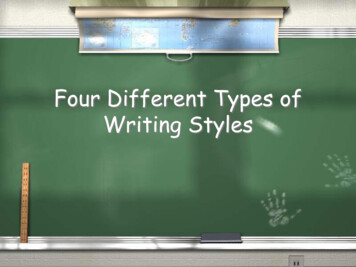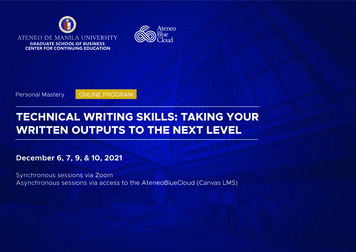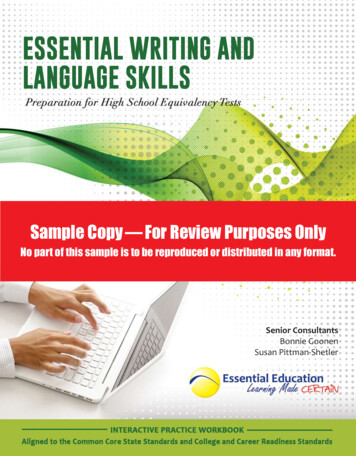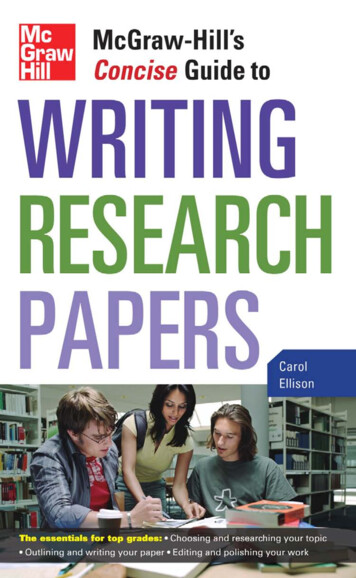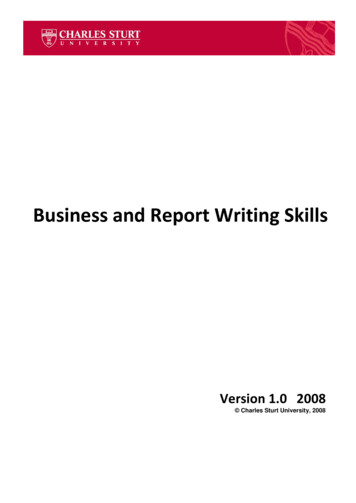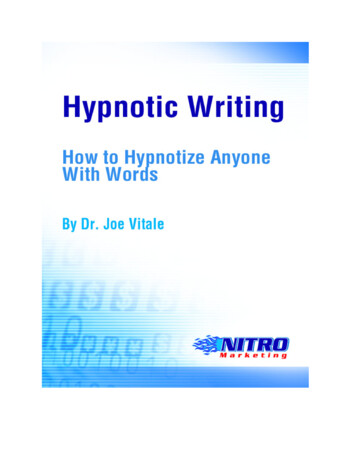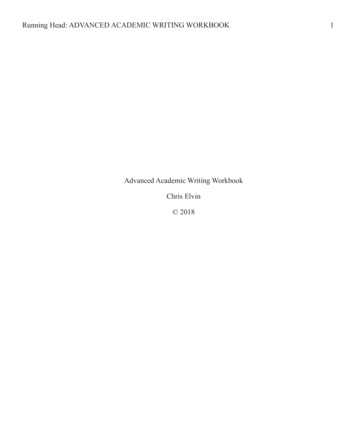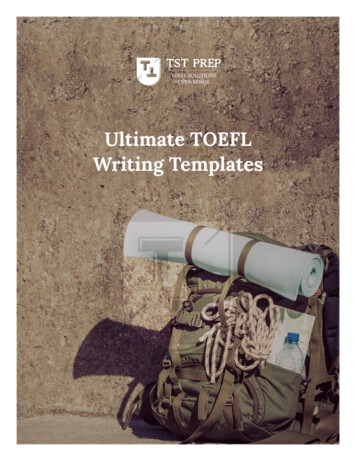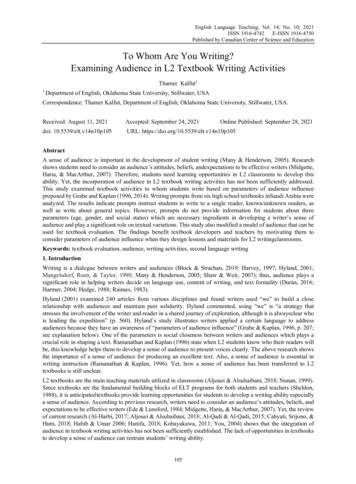
Transcription
English Language Teaching; Vol. 14, No. 10; 2021ISSN 1916-4742E-ISSN 1916-4750Published by Canadian Center of Science and EducationTo Whom Are You Writing?Examining Audience in L2 Textbook Writing ActivitiesThamer Kalfut11Department of English, Oklahoma State University, Stillwater, USACorrespondence: Thamer Kalfut, Department of English, Oklahoma State University, Stillwater, USA.Received: August 11, 2021Accepted: September 24, 2021Online Published: September 28, 2021doi: 10.5539/elt.v14n10p105URL: https://doi.org/10.5539/elt.v14n10p105AbstractA sense of audience is important in the development of student writing (Many & Henderson, 2005). Researchshows students need to consider an audience’s attitudes, beliefs, andexpectations to be effective writers (Midgette,Haria, & MacArthur, 2007). Therefore, students need learning opportunities in L2 classrooms to develop thisability. Yet, the incorporation of audience in L2 textbook writing activities has not been sufficiently addressed.This study examined textbook activities to whom students write based on parameters of audience influenceproposed by Grabe and Kaplan (1996, 2014). Writing prompts from six high school textbooks inSaudi Arabia wereanalyzed. The results indicate prompts instruct students to write to a single reader, known/unknown readers, aswell as write about general topics. However, prompts do not provide information for students about threeparameters (age, gender, and social status) which are necessary ingredients in developing a writer’s sense ofaudience and play a significant role on textual variations. This study also modified a model of audience that can beused for textbook evaluation. The findings benefit textbook developers and teachers by motivating them toconsider parameters of audience influence when they design lessons and materials for L2 writingclassrooms.Keywords: textbook evaluation, audience, writing activities, second language writing1. IntroductionWriting is a dialogue between writers and audiences (Block & Strachan, 2019; Harvey, 1997; Hyland, 2001;Mangelsdorf, Roen, & Taylor, 1990; Many & Henderson, 2005; Shaw & Weir, 2007); thus, audience plays asignificant role in helping writers decide on language use, content of writing, and text formality (Durán, 2016;Harmer, 2004; Hedge, 1988; Raimes, 1983).Hyland (2001) examined 240 articles from various disciplines and found writers used “we” to build a closerelationship with audiences and maintain peer solidarity. Hyland commented, using “we” is “a strategy thatstresses the involvement of the writer and reader in a shared journey of exploration, although it is alwaysclear whois leading the expedition” (p. 560). Hyland’s study illustrates writers applied a certain language to addressaudiences because they have an awareness of “parameters of audience influence” (Grabe & Kaplan, 1996, p. 207;see explanation below). One of the parameters is social closeness between writers and audiences which plays acrucial role in shaping a text. Ramanathan and Kaplan (1996) state when L2 students know who their readers willbe, this knowledge helps them to develop a sense of audience to present voices clearly. The above research showsthe importance of a sense of audience for producing an excellent text. Also, a sense of audience is essential inwriting instruction (Ramanathan & Kaplan, 1996). Yet, how a sense of audience has been transferred to L2textbooks is still unclear.L2 textbooks are the main teaching materials utilized in classrooms (Aljouei & Alsuhaibani, 2018; Nunan, 1999).Since textbooks are the fundamental building blocks of ELT programs for both students and teachers (Sheldon,1988), it is anticipated textbooks provide learning opportunities for students to develop a writing ability especiallya sense of audience. According to previous research, writers need to consider an audience’s attitudes, beliefs, andexpectations to be effective writers (Ede & Lunsford, 1984; Midgette, Haria, & MacArthur, 2007). Yet, the reviewof current research (Al-Harbi, 2017; Aljouei & Alsuhaibani, 2018; Al-Qadi & Al-Qadi, 2015; Cahyati, Srijono, &Hum, 2018; Habib & Umar 2006; Hanifa, 2018; Kobayakawa, 2011; You, 2004) shows that the integration ofaudience in textbook writing activities has not been sufficiently established. The lack of opportunities in textbooksto develop a sense of audience can restrain students’ writing ability.105
elt.ccsenet.orgEnglish Language TeachingVol. 14, No. 10; 2021In Saudi Arabia, the Ministry of Education has recently issued English language textbooks to be used for highschool. The Ministry set up learning objectivesper grade level for writing skill development. Audience is one of theobjectives, as shown in Table 1. Likewise, all teachers’ manuals of Traveller series textbooks 1-6 emphasize theimportance of raising students’ awareness of audience. One manual lists audience concerns in the writing section:“The writer must take many things into consideration: handwriting, spelling, punctuation, paragraphing, purpose,audience and syntax. For this reason, the course [textbook] has paid particular attention to [writing]” (Traveller 1Teacher’s Manual, p. 4). The other Traveller textbooks have similar statements, which indicate that audience is amain component of each textbook. In addition, it is important to have a sense of audience in the Saudi Arabiancontext because considerable social parameters (e.g., gender, age, and social status) play a vital role in shapingpeople’s interactions, due to Arabic traditions. Tawalbeh and Al-Oqaily (2012) gave Saudi and American collegestudents a written discourse completion test and found Saudis used different request strategies whencommunicating with people of low/high social statuses, demonstrating the impact of social status on Saudicommunication.Table 1. Learning Objectives of Writing Skills Set Up by Ministry of Education (2014-2020)No. Learning objectives of writing skillsaGrade110th“Deal with specific aspects of writing (paragraphing, purpose, audience,cohesion, coherence)” (p. 57).2“Deal with specific aspects of writing (paragraphing, purpose, audience,11thregister, cohesion, coherence)” (p. 64).3“Deal with specific aspects of Writing (paragraphing, purpose, audience,12thstyle, register, cohesion, coherence, organisation)” (p. 70).aNote. emphsis addedDespite the importance of heightening students’ awareness of audience when developingwriting skills, Saudi highschool English language textbooks have not undergone thorough investigation to determine whether and howwriting activities align with the Ministry’s learning objectives of writing skills. Therefore, this study sought toidentify whether and if so how high school English language textbook developers in Saudi Arabia construct a senseof audience in the writing activities. In particular, this study examined to whom students write. Analysis adaptedGrabe and Kaplan’s (1996, 2014) model of audience parameters to analyze writing prompt activities within thebroad ecology of a learning unit. Findings can benefit textbook developers by offering them parameters fordesigning materials. They also raise teachers’ awareness of the relationship between a writer and audience inwriting activities offered in L2 textbooks, and in consequence, the findings can contribute to the effective teachingin L2 classrooms.2. Literature Review2.1 Model for Parameters of Audience InfluenceTo gain insight into the development of student writing ability as it relates to engagement with various audiences,it is necessary to identify parameters related to prospective audiences. Grabe (1990) and Grabe and Kaplan (1996,2014) suggest a model called parameters of audience influence that is recognized in research related to the writingcontext (see Cho & Choi, 2018; Fongoqa, 2002; Mthembu-Funeka, 2009; Shaw & Weir, 2007). This modelcontains five parameters which have an impact on textual variations. The first is the number of text readers.Writers write for oneself, an individual, a small or wide group of people, or the public. The second is whetherreaders are known or unknown. It refers to the degree of closeness between writers and audiences, such as whetherthey are colleagues or strangers. The third is the social status of a person (e.g., a well-known scholar). An audiencehas a higher, equal, or lower status than the writer. The fourth is whether a writer and audience share backgroundknowledge. When a writer and the audience are familiar with an event in a certain cultural context, the writerprovides less information because he/she assumes readers have this shared knowledge. The last is whether a writerand audience share specific topical knowledge. This knowledge leads a writer to utilize general versus professionalterms. According to He and Shi (2008, 2012), specific topical knowledge also refers to specific cultural knowledgewhere topics are only relevant to a certain community. In a nutshell, the model provides five factors that writersshould take into account while writing a text to address audiences properly.Despite the impact of Grabe and Kaplan’s (1996, 2014) model in the teaching of writing, it still lacks two aspectsthat have an impact on developing a sense of audience. The first is gender of audience. Johnson (1992) found amale addressee received more closing compliments from L2 student writers than a female addressee. The second is106
elt.ccsenet.orgEnglish Language TeachingVol. 14, No. 10; 2021age of audience. A study by Frank (1992) found fifth grade students adapted writing according to their audienceages; their writing to a third-grade audience wasmore successful than to an adult audience because they succeededin considering a third-grade audience’s expectations more than an adult’s. Therefore, it is significant to considerthese two key aspects in examining the audience concept in the Saudi textbooks because Saudi Arabia has asensitive communication system build on Arabic values, where gender and age play a role in shaping people’sinteractions. The adding of these aspects to Grabe and Kaplan’s model of audience will also make it morecomprehensive (see Figure 1). These two aspects and the other parameters suggested by Grabe and Kaplan areexamined to observe whether they have been taken into account when developing writing activities in L2textbooks in Saudi Arabia.Figure 1. Parameters of Audience Influence (Adapted from Grabe & Kaplan 1996)2.2 Research on Parameters of Audience Influence in L2 TextbooksThe examination of audience in L2 textbook writing activities began in the late 1990s when Johnston (1996)studied, in part, whether a sense of audience was encouraged in seven ESL global textbooks. He found a teacher’stextbook provided information about the importance of audience in L2 writing, but a student’s textbook offeredlimited writing activities to address audience. This lack of audience in textbooks was argued to limit students’understanding of intended readers and led to the question: to whom are they writing?Although Johnston’s findings suggest the need for a broader investigation into audiencewithin L2 textbook writingactivities, previous research has neglected studying this important issue. Instead, much research on L2 textbookshave other aims. First, numerous studies have evaluated the weaknesses and strengths of a textbook based on aLikert scale checklist (e.g., learning objectives, layout, etc.), but they have not examined the incorporation ofaudiences in textbooks (Al-Hajailan, 1999; Alhamlan, 2013; Al-Harbi, 2017; Alharbi, 2015; Aljouei &Alsuhaibani, 2018; Almalki, 2014; Al-Sowat, 2012; Ahour, Towhidiyan, & Saeidi, 2014; Jahangard, 2007;Hammad, 2014; Hanifa, 2018; Henriques, 2009; Zohrabi, Sabouri, & Behroozian, 2012). Second, limited studieshave examined the incorporation of writing activities in L2 textbooks, but findings are not specific to audience inL2 writing (Al-Qadi & Al-Qadi, 2015; Cahyati, Srijono, & Hum, 2018; Habib & Umar 2006; Kobayakawa, 2011;You, 2004).A few studies have examined both audience and writing activities in textbooks (Ramanathan & Kaplan, 1996; Liao& Chen,2009). Ramanathan and Kaplan (1996) examined the incorporation of “audience” and “voice” in tenwriting textbooks used in an undergraduate composition program in the U.S. These textbooks are used by nativeand non-native students. The researchers found a serious problem: textbooks rely on shared cultural knowledgethat non- native students do not have. For example, non-native students are asked to write about gun control, butthey are unfamiliar with this topic because they have minor gun-related crimes in their nations. These topicsdisadvantage L2 students to involve with the textbooks and hinder students’ development. Except knowledge oftopics, Ramanathan and Kaplan’s study does not examine other parameters mentioned above by Grabe and Kaplanand other researchers. Another study was carried out by Liao and Chen (2009). They conducted a comparisoninvestigation of argumentative rhetorical strategies offered in textbooks used in Taiwan: three high school Chinesecomposition textbooks and three college English composition textbooks. One of the nine questions in this studywas about the audience roles. They found both the Chinese and English textbooks draw student attention to theimportance of audience in writing an effective text, but the English textbooks provide more details about potentialaudiences. The study reported an English textbook gives students opportunities to address four roles of audiences:supportive, neutral, resistant, and completely resistant. Each role requires a certain treatment in argumentativewriting. When a writer and supportive audiences have a similar view on a topic, a writer may only need to state that107
elt.ccsenet.orgEnglish Language TeachingVol. 14, No. 10; 2021view without discussing the opposing opinion. When students write to neutral audiences, they are instructed tofairly summarize the opposite opinions and then disprove them. For the resistant audiences, the English textbookinstructs students withhold their view until the end of the argument. Finally, regarding completely resistantaudiences, the English textbook suggests students highlight the common goals and beliefs shared by the writer andtheir audience. However, the Chinese textbooks do not provide such details while discussing audience. Theyconcluded the English textbooks are audience-oriented, but the Chinese textbooks are less audience-oriented. Thisexample shows how the roles of audience inform the selection of argumentative writing strategies to fulfill aparticular purpose. Liao and Chen’s study did not examine other parameters mentioned by Grabe and Kaplan andother researchers except roles of audience. In short, the above two studies have examined only one parameter ofaudience influence. They have not educated us about the incorporation of other parameters of audience influencein L2 textbooks. Furthermore, Saudi Arabia has a communication system which is influenced by Arabic traditions.In this system, gender and age are important in shaping people’s interactions. Therefore, it is important to considerthe concept of audience in the Saudi textbooks based on these parameters. Thus, it seems crucial to shed light onhow these parameters have been addressed in high school L2 textbooks. Also, Liao and Chen show that audience isaddressed differently in Chinese textbooks and English textbooks. It would be interesting to discover whether L2textbooks in Saudi Arabia are audience-oriented, matching English textbooks, or less audience-oriented, similar toChinese textbooks. Therefore, there is a need to conduct further research to address this issue to broaden ourunderstanding of the parameters of audience influence offered in L2 Saudi Arabian textbooks.Due to the importance of parameters of audience influence in the development of student writing ability and thelack of studies addressing this matter in high school L2 textbooks as part of school curriculum, this study addressedone research question:To what extent do writing prompts in the Traveller series textbooks in Saudi Arabia take into considerationparameters of audience influence?3. Method3.1 Data Collection (Textbook Description)The collected data are six students’ textbooks called the Traveller series. They are designed for high school(10th-12th grades) based on the guidelines of the Ministry of Education in Saudi Arabia for the 2017-2018academic year. The proficiency levels are based on the Common European Framework of Reference for languages(CEFR).3.1.1 The Structure of a Whole Learning UnitThe textbooks are designed based on an integrated approach that focuses on teaching the four skills. Also, thetextbooks include sections about grammar and vocabulary in each unit. Each textbook contains four to ten learningunits. Each unit is built around one topic. There are several lessons in each unit and they are thematically connectedto the general topic. Figure 2 shows five lessons offered in Traveller 1-Unit 1. The length of each lesson is twopages. The lesson consists of several sub-sections: vocabulary, pronunciation, grammar, reading, listening,speaking, writing, and practice. The theme is “Youthculture.” A writing section appears at the end of each writinglesson. Appendix A and B provide examples of two lessons (1C and 1E), which both contain writing sections.108
elt.ccsenet.orgEnglish Language TeachingVol. 14, No. 10; 2021Figure 2. Example Unit Structure with Lessons, Sections, and Activities (Traveller 1)The writing sections do not contain activities that are independent of other activities in the unit. Instead, the writingsections are part of a broader ecology of activities that build upon skills learned earlier in the unit. Figure 3provides a concept map of how activities from Lesson 1C “That’s me” are connected to the activities within thewriting section. The arrows from section 1 to section 6 indicate each section is connected to the three activities inthe writing section. Section 1 introduces phrases (e.g., is a big fan of) to describe things that a student likes ordislikes. The same phrase is utilized in the reading passage in the writing section (e.g., I am a big fan of sport). Thisexample illustrates the connection between the vocabulary section and the reading activity within the writingsection. The reading passage demonstrates for students how a writer uses the above phrase to present himself.Therefore, it is assumed that the vocabulary section provides students with language tools that assist them inwriting about themselves at the end of this lesson.Figure 3. The Integration of All Activities into the Writing Section (Traveller 1)109
elt.ccsenet.orgEnglish Language TeachingVol. 14, No. 10; 2021This study examined writing activities which appear within the writing section. Particularly, due to the purpose ofthis study (to whom students write), the focus was on analyzing writing prompt activities (N 49) which appear atthe end of each writing lesson. Careful consideration is placed on how activities are integrated into the broaderecology of the textbook unit; thus, specific examples are extracted from the unit to show the interconnectednessbetween writing prompt activities and other activities.3.2 Data AnalysisA mixed methods data analysis program called MAXQDA (2018) was used to conduct a content analysis ofwriting prompt activities appearing at the end ofeach writing lesson and then automatically count the frequency ofactivities in the textbooks. Also, writing activities and the TIP boxes in the writing sections in all textbooks wereexamined to observe if a sense of audience has been taken into consideration in the writing sections. In addition,learning activities (listening, speaking, reading, grammar, etc.) in one textbook from each grade (Traveller 1 fromthe 10th grade, Traveller 3 from the 11th grade, and Traveller 5 from the 12th grade) were analyzed to study theintegration of audience in the broader ecology of a learning unit.Grabe and Kaplan’s (1996, 2014) model, which has five parameters of audience influence, was utilized to analyzethe data. The parameters are: number of text readers, degree of social closeness, degree of social status, sharedbackground knowledge, and shared specific topical knowledge. Two parameters (gender of audience and age ofaudience) were added due to past research that show these parameters have an influence on the quality of writing(see Appendix C). Then, Brown’s (2007) classification method of analyzing a language lesson in an L2 textbookwas adapted. Brown classifies activities offered in the lesson based on a general taxonomy of language teachingstrategies. Similarly, in the current study, every writing activity was classified based on each parameter and itssub-parameters. One category called “Not mentioned” was created for instances in which information is notavailable in the activity to decide on the parameter. To illustrate the analysis, five examples of writing activities areshown in Appendix D. An automatic random selection of ten activities (20% of data) was employed for intra-raterreliability. The percentage of coding consistency is shown in Table 2 below.Table 2. Percentages of Intra-rater Reliability of Parameters of Audience InfluenceParametersPercentageNumber of text reader100Social closeness90Social status100Knowledge of topic100Gender of audience100Age of audience80In the analysis of writing activities, several aspects of coding were addressed. Regarding the parameter “degree ofsocial status,” previous research indicates social status is “not only situation-specific but also culture-specific”(Economidou-Kogetsidis, 2012, p. 2267). Elders in certain communities must be treated with a high respect due toits local culture toward seniors. This view is applicable to Saudi Arabia, where people show respect to elders.Therefore, in this current study, when a reader of a text is an older person, this activity was coded as “Higher.” Forexample, an activity in the Traveller series textbooks asked students to write to an elder person (a father of yourfriend) and was coded under “Higher.”The parameter “background knowledge of topic” in this study refers to assigned writing topics in the textbooks.Similar to past research mentioned in the literature review section, in this study, knowledge could be either generalknowledge or specific knowledge.General knowledge of topics refers to knowledge that many people in the world have as shown in this example:“write a paragraph explaining why you want to learn English” (Traveller 3, p. 11). So, this is a general topic thatlearners can write about regardless of their nationalities. On the other hand, specific knowledge of topics refers toknowledge that a certain group of people possess and can be broken down into two types. The first is culturalknowledge of certain events that belong to a certain community, such as Saudi Arabia. The second is topicalknowledge of a scientific field, such as mechanical engineering. Therefore, a writing prompt in the textbooks wascoded under one of the above categories of knowledge.From the content analysis of writing activities concerning the parameter “gender of audience,” two distinctionswere made. First, a certain category called “Pronoun Usage to Indicate Either Gender” was created to code anactivity which appeared several times, as shown in this example: “A friend of yours has recently moved away to110
elt.ccsenet.orgEnglish Language TeachingVol. 14, No. 10; 2021another city. Write a letter to him/her with all your news” (Traveller 3, p. 43). Second, activities which used malenames (e.g.,Victor) were coded under the category “Male.”Regarding the parameter “age of audience,” since these L2 textbooks are written for high school students, it isassumed that their friends are also in the same age. For this reason, every writing prompt in the textbooks instructsstudents stating “write to your friend” was coded under the category “School Age.” When information indicatesthat a friend is an adult age, it is coded under “Adult Age.” For example, write an email to your friend who willcome to your country to study a master program (Traveller 1). This activity was coded under the category “AdultAge” because it is common sense that students in a graduate education level are adults.When the Traveller series textbooks did not provide specific information about the age of readers (e.g., magazinereaders), it was coded as “Not mentioned.”4. Results and Discussion4.1 Audience in Writing Prompts in the Writing SectionsTable 3 shows the results that answer the research question of this study. It reports the numbers and percentages ofparameters of audience influence offered in the six Traveller series textbooks. As mentioned previously, 49writing activities were examined in this study. The following discussion focuses on the findings of writing promptactivities thatappear at the end of each writing lesson.Table 3. The Number and Percentage of Parameters of Audience Influence in Traveller SeriesN%(1) A single person2551(2) The public1020.4(3) Not mentioned1428.6(1) Known reader2040.8(2) Unknown reader1530.6(3) Not mentioned1428.6(1) Higher reader714.3(2) Equal reader1530.6(3) Lower reader00(4) Not mentioned2755.1(1) General knowledge4081.6(2) Specific knowledge918.4(1) Female reader00(2) Male reader510.2(3) Inclusive-gender (he/she)714.3(4) Not mentioned3775.5(1) High school student age1122.4(2) Adult age1224.5(3) Not mentioned2653.1Sub-parametersParameter 1: number of text readersParameter 2: degree of social closenessParameter 3: degree of social statusParameter 4: background knowledge of topicsParameter 5: gender of audienceParameter 6: age of audience111
elt.ccsenet.orgEnglish Language TeachingVol. 14, No. 10; 20214.1.1 Parameter 1: Number of Text ReadersThe number of audience determines the level of communication, where there are several levels, such as dyadic andmass communication (Cleary, 2004; Fielding, 2006). Writing for a single reader, interpersonal or dyadiccommunication, “occurs between two people, and forms the basic unit of communication [it] accounts for mostformal, everyday communication transactions, including personal and intimate relationships” (Cleary, 2004, p. 9).On the other hand, writing for the public, mass communication, is “the transmission of a message to a massaudience it is a one-way form of communication as feedback is limited. There is also no direct or personalcontact between the sender and the receiver” (Cleary, 2004, p. 9). The vast majority of writing activities in theTraveller series instruct students to write to a single reader (51%). This reader is a classmate, a friend, a relative, ora teacher. Comparatively, 20.4% of the writing prompts instruct students to write for the public, such as newsletterreaders. It seems possible to conclude that the Traveller series in Saudi Arabia provide frequent learningopportunities for students to engage with the basic level of written communication, which involves writing for asingle reader. It may be suggested that textbook developers in Saudi Arabia should increase the number of writingprompts offered in the textbooks to write for the public, and as a result, students will have more opportunities topractice writing for mass audiences.Furthermore, the analysis of language activities in the broader ecology of a learning unit in the textbooks showswriting prompts are linked to the theme of a unit, but the activities do not inform students how to write for publicaudiences. The following example illustrates how students are asked to write for a public audience:Read the rubric [writing prompt] below and write the [book] review (120-180 words). Goto the Workbook, p.18.An international magazine has asked readers to submit reviews of their favourite books. Describe yourfavourite book and say what you like about it. (Traveller 6, p. 27)Despite this being a good example for writing to a real-world audience, the prompt has a single tie to otheractivities in the unit. Specifically, the prompt is connected to the theme of the unit. For example, students read ashort passage about a dictionary and answer five questions which focus on reading comprehension. Also, in thespeaking section, students are asked to discuss several types of books (e.g., art books, novels, etc.) that the schoollibrary may purchase. These examples show languageactivities in the learning unit enrich students’ content knowledge of books. However, these activities do notprovide students with necessary content for understanding how to write to publicaudiences.4.1.2 Parameter 2: Degree of Social ClosenessThe results demonstrate writing prompts provide nearly similar learning opportunities for students to write forknown readers (e.g., a friend) and unknown readers (e.g., international magazine readers). Table 2 shows theformer appeared 20 times (40.8%) and the latter appeared 15 times (30.6%) in the Traveller series. A concern mayarise whether students are aware of the importance of this type of social relationship in writing a text. A study byAl-Mohammadiand Derbel (2015) asked students to write an essay providing advice to a tourist who visits Oman.It was found students provide a lot of information in essays about Oman, but this information does not consider aforeigner’s perspective. Students are unable to engage successfully with unknown readers. Therefore, since thiscurrent study provides evidence the Traveller series present opportunities for students to write for known andunknown readers, it is recommended to conduct further research about whether Saudi students are aware of thistype of relationship. This research is not only applicable to students, but teachers may also be interviewed to shedlight on this topic.As mentioned previously, Grabe and Kaplan (1996, 2014) classified the degree of closeness into known andunknown readers. Liao and Chen (20
The examination of audience in L2 textbook writing activities began in the late 1990s when Johnston (1996) studied, in part, whether a sense of audience was encouraged in seven ESL global textbooks. He found a teacher’s textbook provided information about the importance of audience in L2 w




